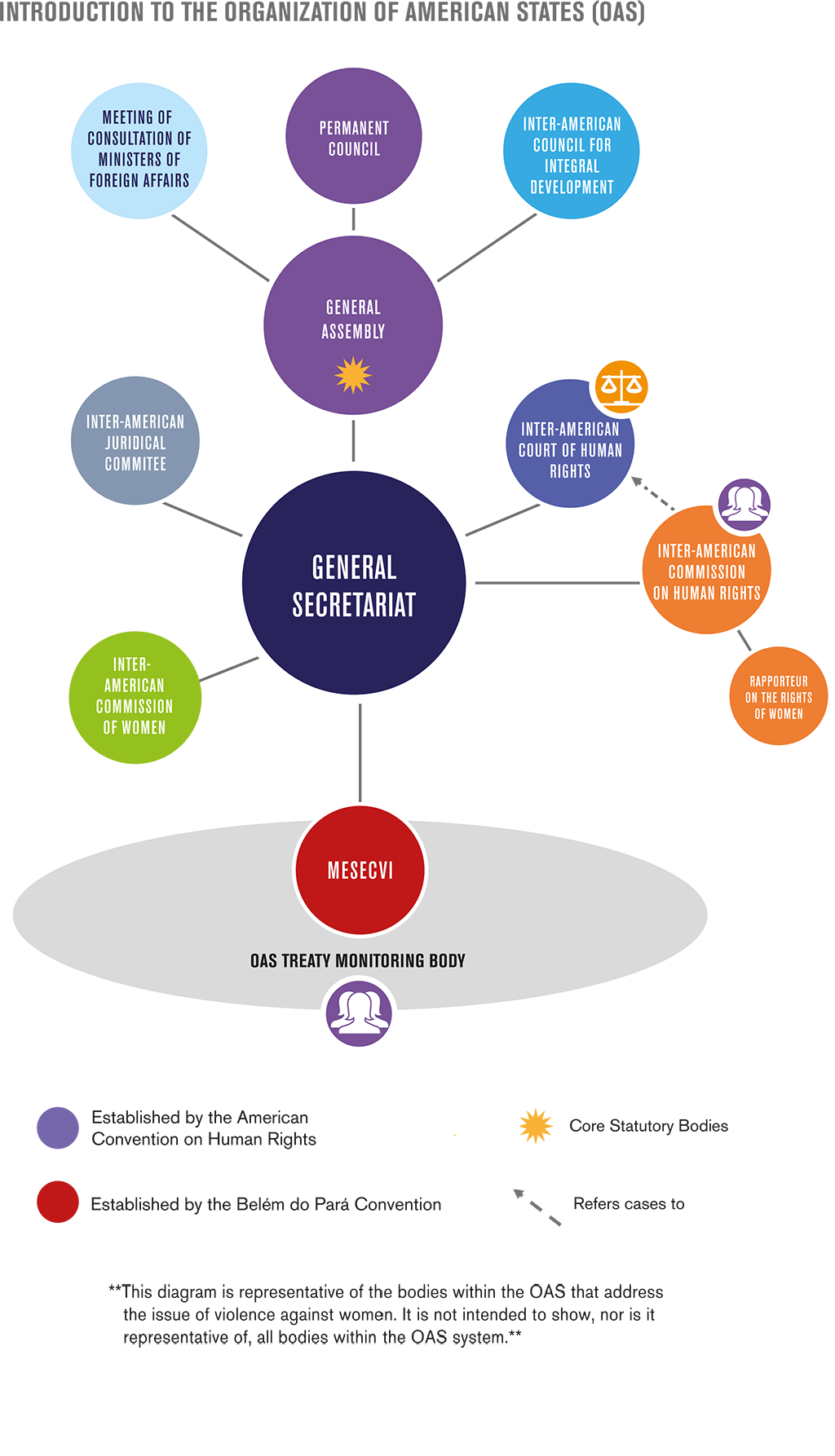
At a glance
Established: 1948
Location: Washington, D.C., USA
Current Membership: 35 states
Official languages: Spanish, English, Portuguese, French
Official website: www.oas.org
Founding document: Charter of the Organization of American States
Core Human Rights Treaties:
VAW Treaty:
- Antigua and Barbuda
- Argentina
- The Bahamas
- Barbados
- Belize
- Bolivia
- Brazil
- Canada
- Chile
- Colombia
- Costa Rica
- Cuba
- Dominica
- Dominican Republic
- Ecuador
- El Salvador
- Grenada
- Guatemala
- Guyana
- Haiti
- Honduras
- Jamaica
- Mexico
- Nicaragua
- Panama
- Paraguay
- Peru
- Saint Kitts and Nevis
- Saint Lucia
- Saint Vincent and the Grenadines
- Suriname
- Trinidad and Tobago
- United States of America
- Uruguay
- Venezuela (Bolivarian Republic of)
Which bodies are most effective in tackling violence against women?
Each body within a system can contribute to gender equality and tackling violence against women, however some have more opportunities to do so than others. Read the descriptions below for a quick introduction to the main OAS bodies relevant to violence against women or click the related link on the right-hand side of this page (or, for mobile users, at the bottom of the page) for more information.
The Convention of Belém do Pará is one of only two legally binding treaties in the world exclusively focused on the elimination of violence against women. Drafted by Inter-American Commission of Women and entering into force in 1995, it acknowledges gender-based violence is a violation of women’s human rights and assault on human dignity. The treaty not only identifies the rights of women to be free from violence, but also outlines states’ obligations to tackle violence against women. Both the Inter-American Commission on Human Rights and Inter-American Court on Human Rights accept the Convention as part of their jurisdiction, and it has been applied in landmark cases on gender-based violence – such as Gonzalez et al (“Cotton Fields”) v. Mexico (2009). [Read more…]
MESECVI is the mechanism to follow up on implementation of the Convention of Belém do Pará. Through a multi-dimensional states reporting procedure, the Committee of Experts (CEVI) coordinates with States parties to collect information on violence against women in the region. From this information, CEVI issues specific state recommendations and hemispheric reports on steps that can be taken to tackle violence against women. CSOs are invited to participate throughout the process, including through the submission of parallel reports. [Read more…]
Inter-American Commission of Women (CIM)
The Inter-American Commission of Women is a specialised organisation within the OAS, formed in 1948. It has served as the core women’s rights body and has overseen the adoption of the international treaties that constitute the Inter-American legal framework for women’s rights – including the development and adoption of the Belém do Pará Convention. It regularly works with CSOs to collect information on the status of women and violence in the Americas and issue recommendations to the General Assembly of the OAS. [Read more…]
![]() Inter-American Commission on Human Rights
Inter-American Commission on Human Rights
The Inter-American Commission on Human Rights is one of two organisations within the OAS that make up the Inter-American system for the promotion and protection of human rights (see also the Inter-American Court on Human Rights). It is a quasi-judicial body that fulfils its mandate through three pillars: individual complaints, monitoring and focus on thematic areas of concern. Women’s rights and ending gender-based discrimination is one of the Commission’s primary areas of concern, and it has applied the Belém do Pará Convention throughout its work. [Read more…]
The Rapporteur on the Rights of Women
The Rapporteur on the Rights of Women operates under the authority of the Inter-American Commission on Human Rights. It monitors member states’ legal and procedure-based compliance with its international human rights obligations, specifically defined through the American Convention on Human Rights, Inter-American Declaration on the Rights of Man and the Inter-American Convention on the Elimination of Violence against Women (Belém do Pará Convention). The Rapporteur also advises in the handling of precautionary measures and individual complaints involving violations of women’s rights, and assists in the preparation of reports on cases involving the rights of women, as well as the development of a new jurisprudence with a gender perspective. The eradication of violence against women in all its forms is one of the Rapporteur’s key areas of concern. [Read more…]
![]() Inter-American Court of Human Rights
Inter-American Court of Human Rights
The Inter-American Court on Human Rights is one of two organisations within the OAS that make up the Inter-American system for the promotion and protection of human rights (see also the Inter-American Commission on Human Rights). It is the autonomous judicial organ of the human rights system, and can provide advisory opinions on the interpretation of human rights within the Belém do Pará Convention. It also decides cases referred to it by the Inter-American Commission on Human Rights. The Court has the authority to hold member states responsible for their obligations under the Belém do Pará Convention. [Read more…]
Icon Key




